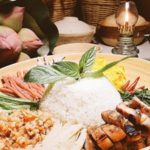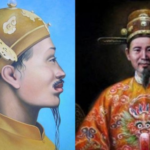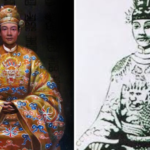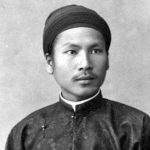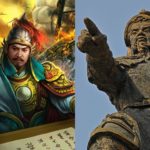Vietnamese women’s attire, from the country’s founding to the end of the Nguyen Dynasty, has always evolved and adapted to historical changes. Despite the era, Vietnamese women’s clothing has consistently left its unique mark. Let’s take a journey through the different periods and explore the diverse styles of the past.
1 Hung Kings Period (2000 BC – 200 AD)
Even in the early days of nation-building, textile arts were highly advanced, with at least two types of plant and fiber-based fabrics available. This allowed our ancestors to create a variety of garments with distinct colors and designs.
Women during the Hung Kings Period typically wore short, belly-length shirts with a chest opening and a tight fit. Underneath, they wore a chest-covering apron with a round neck, adorned with rice grain patterns.

There were also short-sleeved shirts with square necklines, exposing part of the shoulders and chest, or covering the chest while revealing the shoulders and upper back. These could be pullover or left-buttoned styles. All shirts featured decorative patterns, and belts with three rows of evenly spaced dots were wrapped around the waist.
Women of this era also wore pullover shirts with a left flap, tied their hair up, and went barefoot.
For further reference: Origin and Historical Significance
2 Ly Dynasty (11th – 13th Centuries)
The traditional attire of ancient Vietnamese women included head scarves (square scarves), hair scarves, aprons, belts, shirts, skirts, and four- or five-paneled dresses.
The apron, a unique piece of Vietnamese women’s clothing, was a square piece of fabric with a corner cut out to form the neck, while the rest of the fabric covered the chest as an undergarment. Aprons were typically made of silk, fine-fiber fabric, or soft, colorful fabric, excluding black.
Belts were approximately 1.5 to 2 meters long and 15 to 20 centimeters wide, usually woven from rough silk with a length that could wrap twice around the waist and still leave a dangling end for a teardrop knot in the front.

The ends of the belts were left with unwoven longitudinal threads (also known as warp threads) to create tassels for added beauty. The belts were dyed in vibrant rainbow colors. Women often wore two belts, showcasing a variety of hues.
Skirts from this period consisted of three parts: the waistband, the hem, and the body. Formal skirts were long, reaching the ankles. Wealthy women wore silk or fine linen skirts, or opted for thick, glossy silk for added elegance.
For further reference: Collection of 10+ International Women’s Day Articles
3 Tran to Early Le Dynasties (15th – 16th Centuries)
During this time, Vietnam produced various types of fabrics, including Cat Liu brocade, straight-fibered heart-shaped apple brocade, blended fabric, glossy silk, Yi, linen, La, and fine silk. There were also unusual yet excellent fabrics made from hemp and banana fiber, as soft as silk, perfect for summer wear.

Traditional women’s clothing can be divided into two phases. From the 13th to the 15th centuries, shirts featured wide sleeves, and the outer garment had a deep, wide neckline, paired with a tube top underneath. From the 15th to the 16th centuries, during the late Tran and early Le Dynasties, the neckline became more modest with a round collar, and the sleeves were tailored for a neater fit. However, the colors became more elaborate and eye-catching.
Women also wore black shirts, but with white undershirts that extended to the neck and were four inches wide, creating a distinct look. Colors like green, red, yellow, and purple were strictly avoided.
4 Le Dynasty (15th – 16th Centuries)

Heavily influenced by Chinese culture, the clothing of Vietnamese women during the Le Dynasty resembled the Hanfu style of China, featuring wide sleeves and a large belt at the waist to secure the outer garment.
5 Mac Dynasty (16th Century)
In this era, women wore four-paneled dresses with round necks, long belts hanging in front of the abdomen, and long, wide skirts. They wore their hair long, parted in the middle. Aristocratic women favored more elaborate attire, donning colorful streamers that draped to the ground, enhancing their graceful and delicate appearance.

Jewelry also evolved, offering a diverse range of styles and colors, such as flat round bracelets, gourd-shaped earrings, lotus-shaped earrings, and attractive round studs.
6 Later Le Dynasty (17th – 18th Centuries)
During the Later Le Dynasty, various clothing styles emerged, and the outfits began to showcase distinct cultural characteristics. Women’s attire was very modest, consisting of multiple layers of colorful garments. The most distinctive feature remained the wide sleeves.

Court attendants’ attire included round-necked shirts, with options for long or short sleeves, single or layered skirts, and wide or narrow sleeves.
7 Tay Son Period (18th Century)

Women’s clothing during the Tay Son Period was intricate, featuring detailed embroidery and meticulous stitching. As this dynasty was marked by significant wars, women’s attire resembled battle dress, and they wore pants instead of skirts. In the early 19th century, women were prohibited from wearing skirts, as they were considered vulgar.
8 Nguyen Dynasty (19th Century)
In the 19th century, the five-paneled dress gained popularity. This style consisted of two pieces of fabric sewn together to form the front of the dress, adhering to modest standards. The four outer panels symbolized the parents of the wearer and their spouse’s parents, while the fifth panel represented the wearer. The dress always had five buttons, representing the five fundamental principles of humanity: virtue, duty, propriety, wisdom, and trust.
Traditional garments such as the ao dai (long dress), yếm (apron), áo tứ thân (four-paneled dress), khăn mỏ quạ (crow beak hat), and nón quai thao (conical hat) became the cultural essence of the entire nation.

While the yếm (apron) ventured beyond the royal court to accompany hardworking women in the fields, and the áo tứ thân (four-paneled dress) graced the Lim Festival, Western fashion, with its flared skirts and modern dresses, also made its way into the wardrobes of young aristocratic women. Among them was Nam Phuong, the last empress of Vietnam’s feudal era, known for her love of Western clothing and her impeccable sense of style.

For further reference: Collection of 20 Articles on Vietnamese Women’s Day
The information above highlights the unique and diverse clothing styles of Vietnamese women throughout history, each era leaving its mark on the country’s cultural heritage.
See also:
>>
>>
>>
3 Days of Golden Throne : What Did 2 Vietnamese Kings Achieve?
Two Vietnamese kings had short reigns, what did they achieve?


























